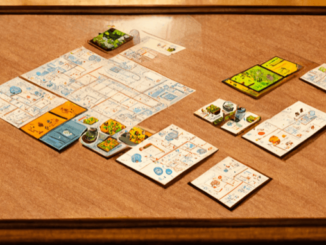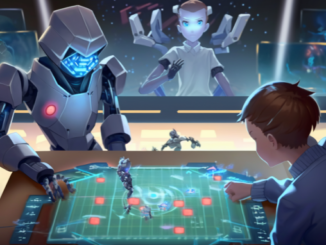
The game 1000 Blank White Cards combines a couple of concepts which could be very interesting to games-based learning creators and facilitators: co-creation of a game, and creation of a game (and its materials and rules), during, and as a result of, play.
The only materials required for the game are pens and a pile of blank white cards – and you don’t need anywhere near 1000 for a single game – around 5 or so per player are sufficient. If you have played before you’ll add 20 – 30 cards from your stockpile; cards surviving from previous games. If not, you’ll need an extra 20 – 30 blank cards.
This also makes this game an interesting one from a facilitation perspective, as it is so easy and inexpensive to set up and play.
Boxes of Blank White Cards are available from Amazon
A (Brief) Description of the Rules and Gameplay

A fuller description of the rules of 1000 Blank White Cards (along with some example cards) has been made available by Riff Conner.
Before the game proper begins, each player takes 5 or 6 blank cards, depending on the number of players, Players will then spend some time creating new cards from the blank ones in front of them.
All ‘rules’ of this game are purely guidelines and can be flouted at will, but a popular convention is that cards should have three parts; a title, a drawing, and an effect.
After the pooling and shuffling of the cards, players are dealt five cards and they will be a mixture of blank and already created cards.
On their turn a player takes a card from the deck and plays one from hand, either on themselves, on another player or to the centre of the table where they will affect all players. Cards which have an immediate, but no lasting effect, are then discarded. Cards with lasting effects or points values remain where they are until the end of the game or until some other effect removes, nullifies or destroys them.
Blank cards in your hand can be turned into playable cards at any point by simply writing/drawing on them.
The game ends when the deck, and all playable cards in hand, are exhausted.
Creating Cards to Play With
As mentioned above, there is a popular convention which results in three-part cards, consisting of title, illustration and action. The action could be an increment (or decrement) of points or any other game-type action e.g. take another turn, discard your hand etc., or any other action ‘do a happy dance’, ‘eat this card’ Adhering strictly to this convention, might, over time, lead to a certain ‘sameyness’, but you are not limited by these conventions. Cards can be far broader in scope, containing or referencing non-card objects, being modified in shape or colour, or containing real world data. Cards can contain references to other games and activities, or even parts or the entirety of other games and activities. They can even encode algorithms.
‘Winning’ at 1000 Blank White Cards

One way of winning at 1000 Blank White Cards is to have the greatest number of points when the game ends. But as it is by no means certain that any of the cards created will have a points scoring action, it may well be that this option for winning is not available in the game.
Many seasoned players of the game consider that the best ‘win’ at 1000 Blank White Cards is having one’s card creation reused from game to game – that one’s ideas and creativity are considered worthy keeping by the group. This ‘win’ therefore occurs after the playing part is over, during the Epilogue
Epilogue – Reusing the Stockpile
During the Epilogue, players collectively decide on the best cards, which will be saved and taken forward into subsequent games. This stockpile itself is likely to grow as you play more games, as more ‘good’ cards will be created. So on your first game you may create a stockpile of say, 30 cards, and as an ongoing play group, you may maintain one of around 90 cards.
On starting your next game, some or all of your stockpile will be added to some new blank cards.
Cards which do not make the cut can be destroyed or archived.
Interesting features
Initially, it looks like players could easily ‘win’, and just as easily, spoil the game, by say, creating a card that awards a billion points and playing on themselves, but that kind of aggressive play is only likely to inspire other players to create other cards which make you eat or otherwise destroy your million points. It is almost impossible to win intentionally.
Given this, most players will play the game for the reward of having their cards appreciated, either during play, or during the Epilogue. They will want to create interesting gameplay and interaction with the other players. Or they may wish to be rewarded by the admiration of their artworks or the jokes on their cards.
The Epilogue is a democratic process and works in much the same way as dot-voting in a facilitated situation, and could be used to produce similar interactions.
Because cards will be created during play, and very often as a response to other cards that have been previously played, the play of 1000 White cards is adaptive and emergent, and is also very good for demonstrating and exploring the concepts of adaptation and emergence themselves.
Rule modification is both the central mechanic and the purpose of the game, creating a chaotic gameworld of action and reaction, in which it is impossible to settle on a strategy for success.
Similar Games

Nomic – Because the rules for 1000 Blank White Cards are (almost) entirely held on the cards themselves, it is often compared to Nomic. In Nomic, the main action that a player takes is to propose a rule change. All players then vote on whether that rule should be adopted or not. This game demonstrates the concept that in system where rule changes are possible, situations my arise where it is no longer possible to interpret what is legal and what is not, or even that rules may come to be contradictory.
Fluxx – Probably the most well-known commercially produced rule-changing game, Fluxx now has many flavours from Adventure Time Fluxx to Zombie Fluxx, but all work by constantly changing the rules and also the goals that players are striving for to win the game. Not only does this constantly shift the win-state, but also the means by which they can achieve that end.
Dvorak – containing aspects of both 1000 Blank White Cards and Nomic, Dvorak uses cards created by players – which can be of two kinds, Things or Actions. When a new card is proposed, players vote on whether it should be shuffled into, or excluded from the deck.
Bartok – A ‘shedding’ card game (where one wins by getting rid of all cards in hand), Bartok is similar to the other games mentioned her, as the winner of each round gets to create a new rule, which then applies for the rest of the game. A game will thus get more complex with each round. It also allows for vetoes of new rules, if all players but the rule proposer choose to do so.
Baba Is You – An innovative puzzle game where players complete a level by getting the Baba character to an exit point. This can only be achieved by changing the rules about how Baba interacts with the world and vice versa, or indeed changing what or who Baba is, hence the name of the game.
Transferable Play Concepts
There are a number of play concepts which could be taken from 1000 Blank White Cards (and the other games mentioned here), and applied to games-based learning practice.
- Creation of materials on the fly, both removes the burden on the facilitator to create materials beforehand, but, more importantly, ensures absolute relevance to the learning cohort.
- The chaotic gameworld created by the changing of rules as the game proceeds provides an ideal environment for learning around uncertainty, risk and situations of less-than-perfect knowledge.
- The flexibility of the opportunities for materials creation means that appropriate materials can be created for any learning topic, and create experiences completely inside the game ‘magic circle’ or which permeate the barrier between that and the real world.
- The Stockpile can represent a transferable storehouse of knowledge or practices to pass from one learning session /cohort to many more in the future.
- The principle of democratic rule-making can ensure all voices are heard
Some Applications in Organisational Learning

While the somewhat anarchistic ethos of 1000 Blank White Cards can make it difficult to apply, as is, to learning in an organisational setting – except perhaps, in the context of creativity play – the elements which make it up have a lot to offer.
When a cohort of learners creates a set of cards with which they will play, they are creating a ‘system’ to explore whatever learning they intend. While the original game revels in its near-total absence of rules, it will not take too much of a starting rule set to steer the material creation towards a specific focus – the desired ‘to-be’ state of an organisation (with its ideal processes, and people, and a scoring mechanism to measure its success), or its undesirable ‘as-is’ counterpart, or an innovation engine – or any other number of systems.
Changing the rules can engender chaos, or it can have focus – reaching a goal, creating a better functioning system. And a democratic process for allowing or disallowing elements into the new better system can allow for deep reflection on whose voices are heard, and whose are not in organisational change processes
The transferability of the stockpile presents a number of opportunities in organisational learning. For example, it could enshrine valued knowledge, culture or process, or take the output from one learning session into a diametrically opposed second session – creating a problem first and then seeking solutions. It could create a record of progress through a learning process.
I hope you enjoy playing with some of the ideas discussed above. Please share anything it brings up for you or any designs you work up.
Boxes of Blank White Cards are available from Amazon
- James Bore – The Ransomeware Game - 13th February 2024
- Ipsodeckso – Risky Business - 23rd January 2024
- Review – Luma World Games - 15th December 2023





WOW. Just Wow. Nver heard of this… and So simple!